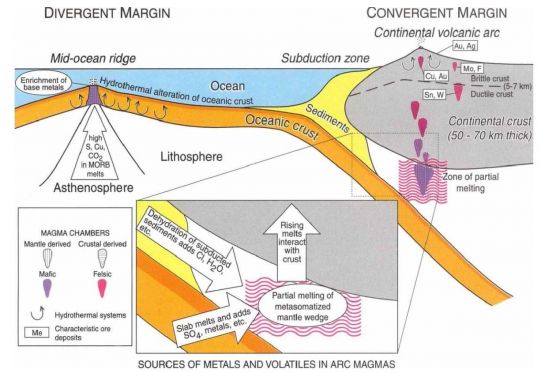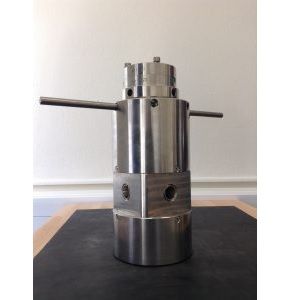PhD student at ISTO laboratory – October 2020 / September 2023
Role of magmatic degassing in the production of metal and metalloid-enriched fluids (Sb, Hg, As, W, Au, Ag)
PhD student: Valentin Mollé1
Supervisor: Giada Iacono-Marziano1
Co-supervisors: Éric Gloaguen1,2, Johann Tuduri2
1: ISTO, 2: BRGM
Hydrothermal activity is linked to magmatic activity: magmatic systems supply heat to hydrothermal systems above them, allowing hydrothermal processes to occur. These processes are often linked to ore deposits (Figure 1), as hydrothermal fluids can mobilize, concentrate and deposit metals and metalloids (Hedenquist and Lowenstern, 1994). Transport and deposit of main critical elements by these fluids are usually well studied and integrated into metallogenic models.

However, metal and metalloids sources in such systems are still discussed. Two main hypothesis are confronted: these elements could be leached from the surrounding rocks by hot hydrothermal fluids; but they could also concentrate into magmatic fluids during magma degassing (Hedenquist and Lowenstern, 1994). In the second case, magmas would not only act as a heat provider, but also as a fluid and critical elements provider for the hydrothermal system and ore deposits. To address this discussion, it is necessary to assess critical elements mobility from magmas to magmatic fluids.
This mobility is poorly understood. Most studies focus on low temperature hydrothermal fluids or porphyric systems rather than magmatic conditions. In addition, studies in magmatic conditions mostly take interest on felsic compositions. The few results available show great disparities (Figure 2), for each element and also between them (Pokrovski et al., 2013).

Recently, a study by Pochon et al. (2016) highlighted a spatial and chronological correlation between Sb, Hg ± As, W, Au, Ag mineralisations and a mafic magmatism event, around 360 Ma ago, in the Variscan Armorican belt (Figure 3). Such correlation have also been shown in the Hg metallogenic district of Almadén in Spain. However, there are no causal processes identified.

Assessing magmatic mobility for target elements is then required to understand if mafic magmas could have act as a metal and metalloid-enriched fluid source in these deposits. Such study will not only help to better understand these systems and their metallogenic disparities, but also help to better understand metallogenic models, by clarifying the magmatic role in the genesis of hydrothermal ore deposits.
This PhD will focus on characterising these mobilities, by experimental means. A partitioning coefficients database between silicate melts and magmatic fluids at equilibrium will be realized for target elements, along with a fluid speciation database. The effects of temperature, pressure, oxygen fugacity, magmatic melt composition and magmatic fluid composition will be investigated. A special attention will be held toward the effect of chlorine and sulphur, as they are known to be major ligands for precious metals in the fluid phase (Pokrovski et al., 2013).
Statistical analysis of these databases will allow to build predictive models, thus allowing to predict target elements mobility and fluid phase composition during magmatic degassing, as a function of magmatic parameters. Then, the evolution of the fluid phase during hydrothermal processes will be simulated with existing thermodynamic models. Results will be compared to previous literature and field work, and discussed with the new results provided by the AUREOLE framework. Overall synthesis will help to build better metallogenic models for the target elements.
Two experimental devices will be used. Classic experiments in IHPV (Internally Heated Pressure Vessel) will allow ex-situ, quantitative chemical analyses of the melt and the fluid, using EPMA (Electron Probe Micro Analyser), LA-ICP-MS (Laser Ablation Inductively Coupled Mass Spectrometer) and IR (Infra Red) spectroscopy. More “exploratory” experiments will be done with the new see-through windowed autoclave (Figure 4) built at the Earth Sciences Institute of Orléans (ISTO). Such device will allow to access the in situ speciation of volatile species and metal-volatile complexes in the fluid, by Raman spectroscopy. Coupling in-situ and ex-situ results will allow a comprehensive study of target elements behaviour during magma degassing.

Bibliography:
Hedenquist, J. W., Lowenstern, J. B., 1994. The role of magmas in the formation of hydrothermal ore deposits. Nature 370, pp. 519–527.
Pochon, A., Gapais, D., Gloaguen, E., Gumiaux, C., Branquet, Y., Cagnard, F., Martelet, G., 2016. Antimony deposits in the Variscan Armorican belt, a link with mafic intrusives? Terra Nova 28, pp. 138–145.
Pokrovski, G. S., Borisova, A. Y., Bychkov, A. Y., 2013. Speciation and Transport of Metals and Metalloids in Geological Vapors. Reviews in Mineralogy and Geochemistry 76, pp. 165–218.
Valentin Mollé, PhD student – Experimentalist (Magmatic processes and metallogeny)
I am a French PhD student working at the ISTO laboratory in Orléans, within the framework of the AUREOLE project and the LabEx VOLTAIRE. I started my studies at the University of Nantes, before graduating at the University of Orléans with a “Georesources, Geomaterials and Geodynamics” Master’s degree. Then, I worked for one year at the ISTO laboratory as an engineer. This background gave me a strong interest for physico-chemical processes in geology and metallogeny, along with thermodynamics, statistical analysis and modelling. I specialized in experimental geology and magmatic petrology, allowing me to study magmatic processes at the closest.
I worked in particular on two main subjects, both studied by experimental means. During my Master’s degree internship, I worked on REE (Rare Earth Elements) behaviour during carbonatite crystallisation. The aim was to understand the genesis of REE deposits in carbonatitic settings, by assessing if bastnaesite (a main REE economic mineral) is crystallised from carbonatitic magma or not. During my job as an engineer, I worked on sulphur solubility at anhydrite plus pyrrhotite saturation in silicate melts. The aim was to understand the solubility of sulphur at the most oxidized conditions possible for sulphides to exist, in order to help to produce a complete solubility-speciation model for sulphur in silicate melts.
Before that, I also worked on characterizing opal cracking processes, helped to describe a new mineral called lasnierite, and worked on pezzotaite epitaxy on beryls at the LPGN laboratory in Nantes. As I am interested in mineralogy and gemmology, I also passed a University Diploma of Gemmology in Nantes, working on identifying the mineralogical fauna inside Jharkhand emeralds. These mineralogical works, along with my further experimental works, made me familiar with analysis instrumentation: IR and Raman spectroscopy, SEM, EPMA, LA-ICP-MS...
With this PhD, I want to continue to develop my skills as an experimentalist, by working on subjects of interest to me: magmatic fluids, magmatic processes, and metallogenic issues. This PhD is also an exciting opportunity to work with new devices, like the see-through windowed autoclave built at the ISTO laboratory. This PhD will be an important step in my personal project: working as a university researcher and teacher, specialised in magmatic processes and metallogeny from an experimental angle.
Beside all of that, I’m also a hiking lover, fond of nature, fauna and flora observations. I enjoy games a lot (board and video alike), like to go out with friend as much as I can, have an interest in composing electronic music and dancing, and I like to brew some beer from time to time! I also took a recent interest in speleology and astronomy.


